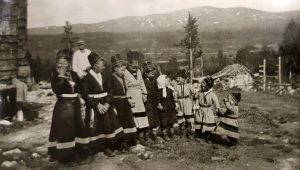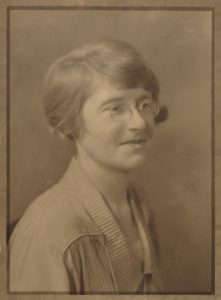March 8, 2022, by Kathryn Steenson
International Women’s Day: Alice Selby
A creative, individual and superb teacher, Alice Selby was a force to be reckoned with when she joined University College Nottingham in 1918 after completing her studies at Cambridge University. She was one of only four academic staff in the English Department, and rising to become Senior Lecturer and Head of English.
She taught Anglo-Saxon, Middle English, the History of Language, as well as the subject dearest to her heart, Old Norse. Her focus was primarily on teaching, including extra-mural teaching in the evenings, rather than research and publication. It was easier to mix and match modules in those early days of the college, and so her students included those taking primarily science based courses with no background in languages or philology, and yet they recalled how she was able to make these dead languages come alive. She taught the language and the sagas as a way to connect to everyday people who had lived a millennium ago, how the words and ideas people use in the stories they tell about themselves reveal more about them than they could have imagined.
In 1931 she embarked on a two-month trip to Iceland, which she recorded in a small exercise book. Her journal, written throughout in pencil and totalling nearly 200 pages, was written between 20 June and 21 August, 1931. In it, Alice Selby recorded observations of customs, costume, language, industry, food, weather, aesthetics and the people that she met as she toured Iceland. The journal is accompanied by 14 black and white photographs showing scenery and people, probably in Iceland although only one photograph is annotated to this effect. A copy of Selby’s journal in substantially revised form was published posthumously in 1974, by the Viking Society for Northern Research.
During WWII she led the English Department. Large swathes of University Park Campus were given over to allotments as part of the Dig for Victory campaign, and in 1940, whilst tending to her vegetables, she found some burned bricks and glazed tiles. The a tiles came from a 15th century medieval kiln that had provided tiles for Lenton Priory (some ruined remains of which are still visible on Gregory Street). There was no time for further archaeological exploration during wartime, and so it wasn’t until the 1950s when the site was excavated, revealing both the kiln and the earlier missing medieval village of Keighton that was abandoned by about 1400.

Photograph of a group of Icelandic people, taken by Alice Selby during her visit to Iceland, 1931. (MS 378/2)
After the war Selby worked part-time at the University until her retirement in September 1950, with the rest of the time spent running Church Farm in Kniveton that she and her sister Dorothea had bought in 1944, and her role on the Rural District Council. She gave up the farm in 1953 but enjoyed a vibrant and busy retirement until her death in the early 1970s.
Alice Selby left little impression in the publication record, with the exception of her extraordinary Icelandic Journal, but it’s clear that she left an enormous impression on those around her. The University of Nottingham continues to have an excellent reputation in what is now the Centre for the Study of the Viking Age, and we have an excellent collection of Icelandic and Travel special collections books available to consult by appointment in the Reading Room.
No comments yet, fill out a comment to be the first



Leave a Reply